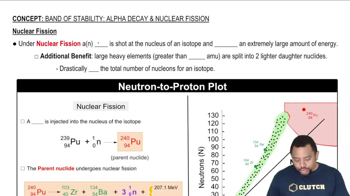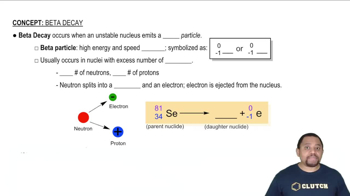Here are the essential concepts you must grasp in order to answer the question correctly.
Nuclear Fission and Fusion
Nuclear fission is the process by which a heavy nucleus splits into smaller nuclei, releasing energy and neutrons. In contrast, nuclear fusion involves the combining of light nuclei to form a heavier nucleus. Understanding these processes is crucial for grasping how breeder reactors operate, as they rely on fission reactions to generate energy and produce fissile material.
Recommended video:
Band of Stability: Nuclear Fission
Beta Decay
Beta decay is a type of radioactive decay in which a beta particle (an electron or positron) is emitted from an atomic nucleus. In the context of the breeder reactor, U-239 undergoes two beta decays to transform into Pu-239. This process changes the atomic number of the element, which is essential for understanding the conversion of U-238 to Pu-239.
Recommended video:
Nuclear Reactions and Equations
Nuclear reactions involve changes in an atom's nucleus and can be represented by nuclear equations that show the reactants and products. These equations must balance both mass and atomic numbers. Writing the nuclear equations for the conversion of U-238 to Pu-239 requires knowledge of how to represent the neutron bombardment and subsequent beta decays accurately.
Recommended video:
 Verified step by step guidance
Verified step by step guidance

